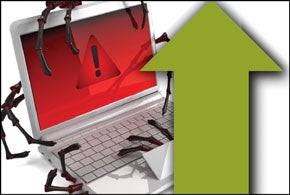
Mobile Malware, Ransomware Increases in 2014
 Spam Levels Dropped
Spam Levels Dropped
72% of e-mail traffic is unwanted advertising, but the amount of it dropped last year because more botnets were traced and removed. As a result, cyber gangs distributed malware through malicious links instead attachments.
 Big Shift Toward Smartphones and Tablets
Big Shift Toward Smartphones and Tablets
Smartphones and tablets outsell desktops by a factor of 10, are a lucrative new target for cyber gangs and “offer other ways to generate a return beyond ‘classic’ spam distribution,” according to the CYREN report.
 Rise in Ransomware Expected
Rise in Ransomware Expected
Ransomware—malware that locks down a computer and the owner is threatened with destruction of his or her data unless they pay to unlock it—is rising.
 Steady Growth of Android Malware
Steady Growth of Android Malware
An average of 5,768 types of Android malware was found per day for the last six months of 2013. Short Message Service Trojan: 73% , Adware: 12%, Backdoor information stealer: 8%, Other: 7%
 Malware Rises
Malware Rises
The number of malware URLs increased 131% last year. Education sites were the most common category, followed by travel, sports and pornography.
 Web Exploit Kits Also Increase
Web Exploit Kits Also Increase
Web exploit kits affect those who visit infected Websites that enable an invisible script to scan their computers. It chooses the right malware to exploit vulnerabilities associated with the user’s browser, OS, PDF reader, etc. They lure victims with posts on social networking sites or e-mail messages with embedded links, often using current news events as bait.
 Bait Used by Exploit Kits
Bait Used by Exploit Kits
Many exploit kits use current events as a lure. Last year’s most popular baits included: September Syria Event: Fake CNN and BBC news links to malware Websites, March Election of Pope: Fake results and fake child abuse rumors, July Royal Baby: Fake status updates and fake live hospital cam
 A Growth in Phishing URLs
A Growth in Phishing URLs
Phishing URLs increased by 264% in 2013. The top phishing categories were: free web pages, education, sports, computers and technology, small shopping and small business sites
 Spam Levels Decrease
Spam Levels Decrease
Spam averages 72% of all e-mail traffic globally. Although it has decreased, the absolute number of messages sent daily remains significant, averaging 78 billion e-mails. By the end of 2013, the average dropped to 57 billion e-mails a day.
 Security Outlook For 2014
Security Outlook For 2014
Viruses, Trojans and spam will become smarter, faster and mobile. Besides event spam, phishing, short malware outbreaks and increased mobile malware, you should be on the outlook for the return of well-established spam techniques, like ASCII spam for using pictures with disruptive pixels, because they can still bypass some traditional filters.